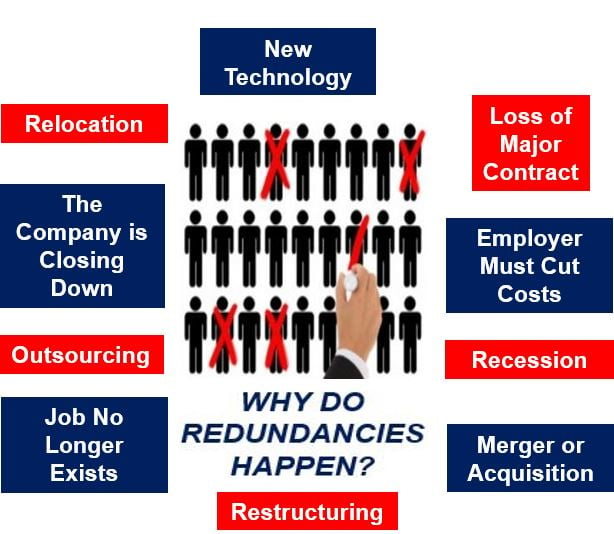Discussed: If a Company Goes Bust Who Pays Redundancy in the UK?
Wiki Article
Exploring the Operational Characteristics of Business Redundancy and Its Long-Term Sustainability

Redundancy Methods for Company Continuity
In order to make sure undisturbed operations, services must apply reliable redundancy methods for organization connection. Redundancy in this context refers to the duplication of vital parts or features within a system to minimize the influence of prospective failures. By incorporating redundancy methods, organizations can improve their resilience against interruptions created by various variables such as all-natural disasters, equipment failures, or cyber-attacks.
One typical redundancy strategy is the implementation of back-up systems and data storage space services. This includes producing matches of essential information and systems that can be activated in case of a main system failing. Furthermore, companies can develop repetitive interaction networks and power sources to preserve connectivity and procedures during unexpected events.
In addition, cross-training staff members to execute several roles within the company can serve as a beneficial redundancy technique. If vital employees are unavailable due to illness or other reasons, this ensures that necessary jobs can still be carried out even. On the whole, effective redundancy techniques are necessary for companies to promote operational continuity and lessen the influence of prospective disturbances.
Impact of Redundancy on Organizational Resilience
Given the vital role redundancy techniques play in guaranteeing company continuity, exploring the effect of redundancy on business strength becomes necessary for understanding the alternative functional dynamics of a company. Organizational resilience refers to an entity's capability to adapt to interruptions, recuperate from troubles, and transform when required while maintaining core features. Redundancy, when tactically executed, can dramatically add to boosting an organization's strength when faced with unforeseen difficulties. By having backup systems, workers, or processes in place, companies can better endure shocks and proceed procedures with very little disturbance.Additionally, redundancy can reinforce employee morale and confidence, understanding that there are backup plans in position to address unanticipated scenarios. This sense of protection can bring about raised performance and an extra favorable job setting. In addition, redundancy can promote technology and creative thinking within an organization as workers feel encouraged to take computed threats, recognizing that there is a safety net to support them in case of failure. Generally, the effect of redundancy on organizational resilience is profound, forming the long-lasting sustainability and success of a business.
Stabilizing Efficiency and Adaptability in Redundancy
Accomplishing an unified stability between operational efficiency and flexible flexibility is an essential difficulty in the strategic implementation of redundancy within organizations. Efficient operations are crucial for keeping productivity and cost-effectiveness, making certain that sources are utilized ideally. Nonetheless, extreme emphasis on efficiency alone can bring about strength, making it tough for organizations to adapt to unpredicted changes look at here or obstacles. On the other hand, flexibility permits companies to react nimbly to advancing situations, fostering advancement and strength. Yet, way too much adaptability without a strong functional structure can cause ineffectiveness and inconsistency.To stabilize effectiveness and versatility in redundancy preparation, companies must thoroughly examine their functional demands, market dynamics, and strategic goals. Executing lean techniques can boost performance by streamlining processes and removing waste, while cultivating a culture of versatility and continual improvement can boost flexibility. Furthermore, purchasing cross-training programs and robust interaction networks can help grow a flexible labor force capable of taking care of diverse tasks during periods of change. Inevitably, finding the ideal balance in between performance and versatility is critical for developing a resistant and sustainable organization despite unpredictability.
Long-Term Sustainability With Redundancy Preparation
To make sure long-lasting practicality and security, organizations need to strategically straighten their redundancy planning with lasting sustainability objectives, consequently integrating operational efficiency with adaptive flexibility. Firms should watch redundancy not as a responsive service to prompt troubles but as a positive method for long-term success.
Positive Measures for Sustainable Firm Operations
Exactly how can companies proactively boost their operational sustainability for lasting success? Executing proactive actions is vital for firms intending to guarantee sustainable procedures.Additionally, fostering a culture of continual renovation and understanding within the organization can enhance versatility to transforming market problems and client demands. Urging staff member participation in decision-making processes and offering possibilities for expert growth can increase spirits, productivity, and overall performance. Developing clear goals, keeping track of vital efficiency indicators, and on a regular basis assessing development are essential parts of positive sustainability monitoring.
Teaming up with providers, consumers, and other stakeholders to advertise lasting practices throughout the supply chain can produce a causal sequence of positive impact - redundancy pay if company goes bust. By taking proactive actions towards operational sustainability, companies can build strength, drive development, and secure their long-lasting success in an ever-evolving service landscape
Verdict

In the world of business monitoring, the tactical implementation of company redundancy stands as a pivotal yet complex method that demands a delicate equilibrium between functional effectiveness and long-lasting viability. By exploring the functional characteristics that underpin business redundancy and examining its wider implications for business durability and versatility, a nuanced understanding of exactly how redundancy techniques can shape the future trajectory of a business begins to unfold.Offered the crucial function redundancy techniques play in making sure business connection, checking out the impact of redundancy on organizational strength becomes necessary for understanding the alternative functional characteristics of a firm. Overall, the effect of redundancy on organizational durability is profound, shaping the lasting sustainability and success of a business.
In conclusion, understanding the functional dynamics of company redundancy is important for making certain long-lasting sustainability.
Report this wiki page